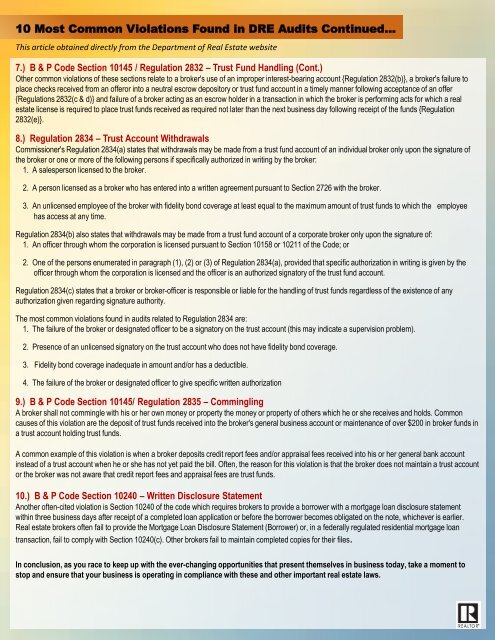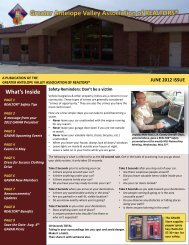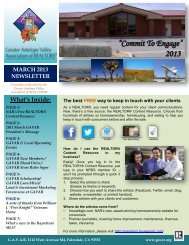May 2013 - Greater Antelope Valley Association of REALTORS
May 2013 - Greater Antelope Valley Association of REALTORS
May 2013 - Greater Antelope Valley Association of REALTORS
- No tags were found...
Create successful ePaper yourself
Turn your PDF publications into a flip-book with our unique Google optimized e-Paper software.
10 Most Common Violations Found in DRE Audits Continued…This article obtained directly from the Department <strong>of</strong> Real Estate website7.) B & P Code Section 10145 / Regulation 2832 – Trust Fund Handling (Cont.)Other common violations <strong>of</strong> these sections relate to a broker's use <strong>of</strong> an improper interest-bearing account {Regulation 2832(b)}, a broker's failure toplace checks received from an <strong>of</strong>feror into a neutral escrow depository or trust fund account in a timely manner following acceptance <strong>of</strong> an <strong>of</strong>fer{Regulations 2832(c & d)} and failure <strong>of</strong> a broker acting as an escrow holder in a transaction in which the broker is performing acts for which a realestate license is required to place trust funds received as required not later than the next business day following receipt <strong>of</strong> the funds {Regulation2832(e)}.8.) Regulation 2834 – Trust Account WithdrawalsCommissioner's Regulation 2834(a) states that withdrawals may be made from a trust fund account <strong>of</strong> an individual broker only upon the signature <strong>of</strong>the broker or one or more <strong>of</strong> the following persons if specifically authorized in writing by the broker:1. A salesperson licensed to the broker.2. A person licensed as a broker who has entered into a written agreement pursuant to Section 2726 with the broker.3. An unlicensed employee <strong>of</strong> the broker with fidelity bond coverage at least equal to the maximum amount <strong>of</strong> trust funds to which the employeehas access at any time.Regulation 2834(b) also states that withdrawals may be made from a trust fund account <strong>of</strong> a corporate broker only upon the signature <strong>of</strong>:1. An <strong>of</strong>ficer through whom the corporation is licensed pursuant to Section 10158 or 10211 <strong>of</strong> the Code; or2. One <strong>of</strong> the persons enumerated in paragraph (1), (2) or (3) <strong>of</strong> Regulation 2834(a), provided that specific authorization in writing is given by the<strong>of</strong>ficer through whom the corporation is licensed and the <strong>of</strong>ficer is an authorized signatory <strong>of</strong> the trust fund account.Regulation 2834(c) states that a broker or broker-<strong>of</strong>ficer is responsible or liable for the handling <strong>of</strong> trust funds regardless <strong>of</strong> the existence <strong>of</strong> anyauthorization given regarding signature authority.The most common violations found in audits related to Regulation 2834 are:1. The failure <strong>of</strong> the broker or designated <strong>of</strong>ficer to be a signatory on the trust account (this may indicate a supervision problem).2. Presence <strong>of</strong> an unlicensed signatory on the trust account who does not have fidelity bond coverage.3. Fidelity bond coverage inadequate in amount and/or has a deductible.4. The failure <strong>of</strong> the broker or designated <strong>of</strong>ficer to give specific written authorization9.) B & P Code Section 10145/ Regulation 2835 – ComminglingA broker shall not commingle with his or her own money or property the money or property <strong>of</strong> others which he or she receives and holds. Commoncauses <strong>of</strong> this violation are the deposit <strong>of</strong> trust funds received into the broker's general business account or maintenance <strong>of</strong> over $200 in broker funds ina trust account holding trust funds.A common example <strong>of</strong> this violation is when a broker deposits credit report fees and/or appraisal fees received into his or her general bank accountinstead <strong>of</strong> a trust account when he or she has not yet paid the bill. Often, the reason for this violation is that the broker does not maintain a trust accountor the broker was not aware that credit report fees and appraisal fees are trust funds.10.) B & P Code Section 10240 – Written Disclosure StatementAnother <strong>of</strong>ten-cited violation is Section 10240 <strong>of</strong> the code which requires brokers to provide a borrower with a mortgage loan disclosure statementwithin three business days after receipt <strong>of</strong> a completed loan application or before the borrower becomes obligated on the note, whichever is earlier.Real estate brokers <strong>of</strong>ten fail to provide the Mortgage Loan Disclosure Statement (Borrower) or, in a federally regulated residential mortgage loantransaction, fail to comply with Section 10240(c). Other brokers fail to maintain completed copies for their files.In conclusion, as you race to keep up with the ever-changing opportunities that present themselves in business today, take a moment tostop and ensure that your business is operating in compliance with these and other important real estate laws.





